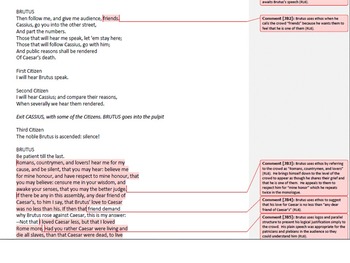Rhetorical and Argumentative Analysis of the Funeral Scene in Julius Caesar
JCBEdPRO
610 Followers
Grade Levels
9th - 12th, Higher Education, Homeschool
Subjects
Resource Type
Standards
CCSSRL.9-10.2
CCSSRL.9-10.3
CCSSRL.9-10.4
CCSSRL.9-10.5
CCSSRL.11-12.2
Formats Included
- PDF
Pages
11 pages
JCBEdPRO
610 Followers
Description
The annotated version of Act III, Scene II of Julius Caesar is aligned with the Common Core emphases on how and why author's use specific rhetorical devices and argumentative appeals to enhance the meaning of the text and develop the characters and themes. The marginal notes for these critical monologues by Mark Antony and Brutus over Caesar's body, are detailed explanations of the appeals and literary and rhetorical devices that highlight this essential dramatic literature selection. The annotated text is an excellent tool for teachers to help them teach students to conduct guided reading, make marginal notes as they read, and it will help teachers to perform a close read of the scene.
Rhetorical and Argumentative Appeal Analysis of the Funeral Scene in Julius Caesar by Dr. Joel Boyce is licensed under a Creative Commons Attribution 3.0 Unported License.
Rhetorical and Argumentative Appeal Analysis of the Funeral Scene in Julius Caesar by Dr. Joel Boyce is licensed under a Creative Commons Attribution 3.0 Unported License.
Total Pages
11 pages
Answer Key
N/A
Teaching Duration
N/A
Report this resource to TPT
Reported resources will be reviewed by our team. Report this resource to let us know if this resource violates TPT’s content guidelines.
Standards
to see state-specific standards (only available in the US).
CCSSRL.9-10.2
Determine a theme or central idea of a text and analyze in detail its development over the course of the text, including how it emerges and is shaped and refined by specific details; provide an objective summary of the text.
CCSSRL.9-10.3
Analyze how complex characters (e.g., those with multiple or conflicting motivations) develop over the course of a text, interact with other characters, and advance the plot or develop the theme.
CCSSRL.9-10.4
Determine the meaning of words and phrases as they are used in the text, including figurative and connotative meanings; analyze the cumulative impact of specific word choices on meaning and tone (e.g., how the language evokes a sense of time and place; how it sets a formal or informal tone).
CCSSRL.9-10.5
Analyze how an author’s choices concerning how to structure a text, order events within it (e.g., parallel plots), and manipulate time (e.g., pacing, flashbacks) create such effects as mystery, tension, or surprise.
CCSSRL.11-12.2
Determine two or more themes or central ideas of a text and analyze their development over the course of the text, including how they interact and build on one another to produce a complex account; provide an objective summary of the text.


